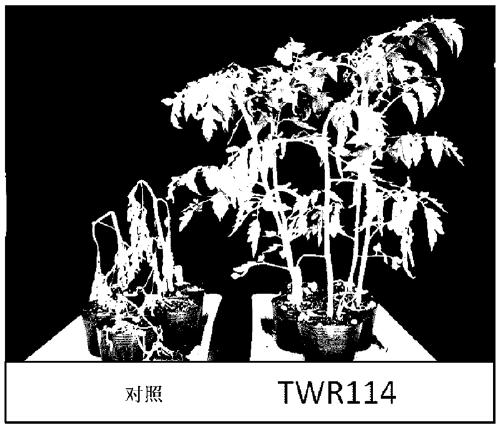Strain belonging to genus mitsuaria and microbial pesticide using said strain
A technology of Songjiang bacteria and strains is applied in the field of plant growth regulators and bacterial plant disease control agents, which can solve the problems of inability to establish and use biological pesticide control methods, insufficient control effects, and unclear effectiveness.
- Summary
- Abstract
- Description
- Claims
- Application Information
AI Technical Summary
Problems solved by technology
Method used
Image
Examples
Embodiment 1
[0081] (Confirmation test 1 for the control effect of tomato bacterial wilt disease)
[0082]Tomatoes (variety: Ponderosa) were grown to the 4th compound leaf stage in plastic pots with a diameter of 9 cm (the bottom layer was 150 g of seedling soil, the middle layer was 20 g of river sand, and the upper layer was 150 g of seedling soil) filled with seedling soil. Then, after mixing 30 ml of the suspension of chitosan-solvating Matsue bacteria TWR114 strain and 70 ml of sterilized water, it was treated in a plastic tank by supplying water from the bottom, and stored in a greenhouse at 30° C. for 3 days. Thereafter, 100 ml of the suspension of Ralstonia solanacearum of tomato was inoculated by the bottom surface water supply treatment similarly. As a comparison, only the suspension of Ralstonia solanacearum of tomato was subjected to bottom surface water supply treatment (no treatment zone). It should be noted that the TWR114 strain suspension was cultured with NB medium (meat...
Embodiment 2
[0088] (Confirmation test for control effect of tomato bacterial wilt 2)
[0089] Tomatoes (variety: Ponderosa) were grown to the 4th compound leaf stage in pots (9 cm x 9 cm) filled with horticultural soil. Then, 30 ml of the TWR114 strain suspension was perfused and stored in a greenhouse at 30° C. for 4 days. Thereafter, 50 ml of tomato solanacearum suspension was inoculated by the same perfusion treatment. As a comparison, only the tomato solanacear suspension was perfused (no treatment zone) and 10 ml of Acinetobacter (Acinetobacter) GEBT349 strain suspension described in Non-Patent Document 1 was carried out by spraying the stems and leaves ( control area). It should be noted that the TWR114 strain suspension and the GEBT349 strain suspension were used in NB medium (meat extract 0.5%, peptone 1.5%, sodium chloride 0.5%, potassium monohydrogen phosphate 0.5%, pH 7.0) Centrifuge at 27°C and 120rpm for 48 hours to collect bacteria (5000×g, 15 minutes), suspend them in st...
Embodiment 3
[0104] (Confirmation test for the control effect of potato bacterial wilt)
[0105] Potatoes (variety: Dejima) were grown to the 4th compound leaf stage in plastic pots with a diameter of 9 cm filled with horticultural soil. Then, 30 ml of the TWR114 strain suspension was poured into a plastic tank, and stored in a greenhouse at 30° C. for 4 days. Thereafter, 50 ml of the potato solanacear suspension was inoculated by the same perfusion treatment. As a comparison, the operation of perfusing only the suspension of Ralstonia solanacearum (no treatment area) and the operation of spraying 10 ml of Acinetobacter GEBT349 strain suspension on stems and leaves (control area) were also implemented. It should be noted that the TWR114 strain suspension and the GEBT349 strain suspension were used in NB medium (meat extract 0.5%, peptone 1.5%, sodium chloride 0.5%, potassium monohydrogen phosphate 0.5%, pH 7.0) Centrifuge at 30°C and 120rpm for 24 hours to collect bacteria (5000×g, 10 mi...
PUM
 Login to View More
Login to View More Abstract
Description
Claims
Application Information
 Login to View More
Login to View More - Generate Ideas
- Intellectual Property
- Life Sciences
- Materials
- Tech Scout
- Unparalleled Data Quality
- Higher Quality Content
- 60% Fewer Hallucinations
Browse by: Latest US Patents, China's latest patents, Technical Efficacy Thesaurus, Application Domain, Technology Topic, Popular Technical Reports.
© 2025 PatSnap. All rights reserved.Legal|Privacy policy|Modern Slavery Act Transparency Statement|Sitemap|About US| Contact US: help@patsnap.com



